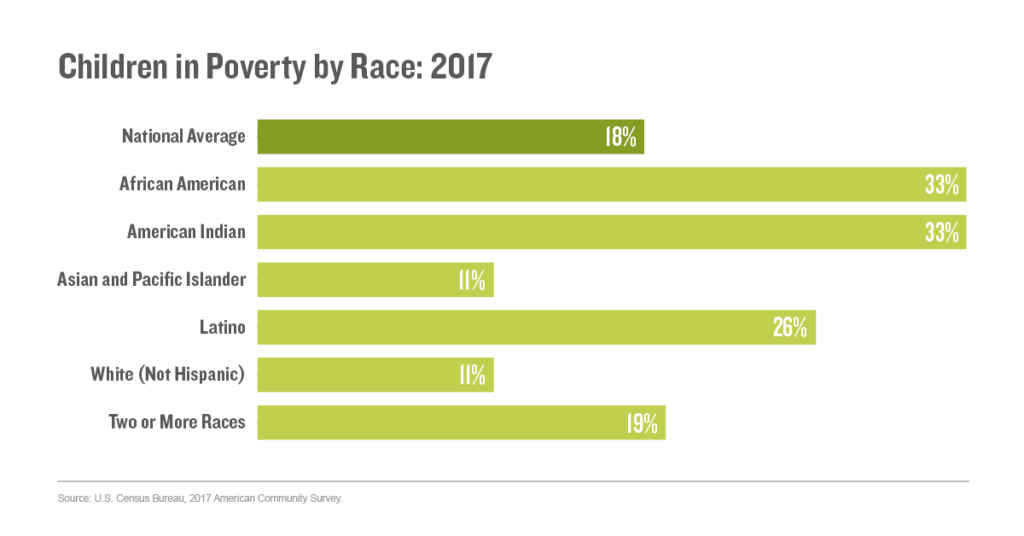
‘Kids Count’ report shows improved child well-being in U.S. – but barriers remain
 The latest edition of the Annie E. Casey Foundation’s KIDS COUNT Data Book is out, and for America’s 74 million children, the news is both good and bad.
The latest edition of the Annie E. Casey Foundation’s KIDS COUNT Data Book is out, and for America’s 74 million children, the news is both good and bad.
The book, published every year since 1990, is the nation’s most comprehensive annual report on child well-being in the United States. The 2019 edition, which was released earlier this summer, compares past data on 16 indicators of health and well-being with figures from 2017, the most recent data available in most cases.
The good news is that the annual report found, broadly speaking, that children in the U.S. had a better chance of thriving in 2017 than in 1990, with improvement in 11 of the 16 KIDS COUNT index measures of child well-being.
The bad news is that racial and ethnic disparities persisted; the U.S. has failed to tear down barriers affecting children of color; and there’s been virtually no progress on child poverty since the publication of the first Data Book in 1990.
“America’s children are one quarter of our population and 100 percent of our future,” said Casey Foundation President and CEO Lisa Hamilton in a statement accompanying the report’s release. “All of the 74 million kids in our increasingly diverse country have unlimited potential, and we have the data, knowledge and evidence to create the policies that will help them realize it. It is incumbent on us to do just that.”
The report found that one in six kids in the U.S. grew up in poverty, presenting tremendous risks to child well-being. The nation’s overall child poverty rate did drop four percentage points to 18 percent in 2017 – but the poverty rate among African American and American Indian kids remains substantially higher – 33 percent.
When it comes to health care coverage, although the percentage of kids not covered by insurance remained steady at 5 percent, 2017 saw an increase in the actual number of kids not covered – the first such increase since 2010, the year Congress passed and President Obama signed into law the Affordable Care Act. Still, the 5 percent uninsured rate is 62 percent better than it was three decades ago – improvement that the report attributes to the ACA, the Children’s Health Insurance Program, and state-by-state Medicaid expansion.
But more bad news: low birth weight, which often portends development challenges, increased three years in a row, matching the four-decade high of 8.3 percent of all live births. (Interestingly, a new report just published based on data from the Centers on Disease Control found the risk of premature birth was higher than expected among Latina women following President Trump’s election in November 2016.)
The report found significant geographic disparities in the well-being of kids. Six of the top 10 states for overall child well-being are in the Northeast. New Hampshire and Massachusetts were in first and second place, followed by Iowa (3), Minnesota (4), New Jersey (5), Vermont (6), Utah (7), Connecticut (8), Maine (9), and Virginia (10).
Conversely, states in the South and the West populate the bottom of the overall rankings. These regions contain the 18 lowest-ranked states. The unhealthiest states for kids were Mississippi (48), Louisiana (49), and New Mexico (50).
The report found that direct lines can be drawn between areas of tremendous improvement in well-being – including health insurance coverage, decreased rates of teen childbearing and increased rates of high school graduation – and policies that have supported these successes. And the Casey Foundation included in the report a number of recommendations for elected officials and other policymakers:
Expand the programs that make and keep kids healthy. For the sake of all children regardless of their immigration status, states should expand access to Medicaid.
Provide the tools needed to help families lift themselves up economically. Federal and state earned income tax credits (EITC) and child tax credit programs mean working parents can devote more take-home pay to meet their children’s needs.
Tear down obstacles faced by children of color. Every child has individual potential, and communities thrive when all kids thrive. African American, Latinx and Native American children remain more likely than others to encounter barriers – from living in high-poverty neighborhoods to not having health insurance – that contribute to negative outcomes. The nation’s public policies must acknowledge and eliminate those obstacles.
Count all kids. Ensure the 2020 Census counts all children, especially those under 5 years old and from hard-to-count areas. The report states that the 2010 Census missed 2.2 million such kids, and the upcoming 2020 Census may miss even more if young children are not a priority. The stakes are high, the report explained – 55 major federal programs, including Head Start, Medicaid, and the Children’s Health Insurance Program, allocate more than $880 billion each year based on Census data.
You can download the 70-page report here or order a copy of the report here.

